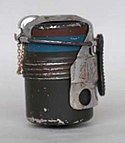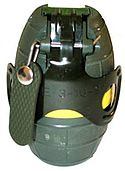Order of Saint Joseph: Difference between revisions
Arthurista (talk | contribs) m (→Equipment) |
Arthurista (talk | contribs) m (→Equipment) |
||
| Line 165: | Line 165: | ||
|----- | |----- | ||
|- style="background:#efefef; color:black" | |- style="background:#efefef; color:black" | ||
| {{wp| | | {{wp|M60 machine gun}} | ||
| [[File: | | [[File:M60GPMG.jpeg|125px]] | ||
| {{flag| | | {{flag|Belfras}} | ||
| Medium Machine gun | | Medium Machine gun | ||
| 7.62×51mm | | 7.62×51mm | ||
Revision as of 01:19, 23 October 2019
| Order of Saint Joseph Supreme Order of the Holy Sepulchre and Brotherhood of Saint Joseph Ordo summi fraternitatis sancti Iosephique sancti Sepulcri | |
|---|---|
| <imgur w=200>1IVAlCr.png</imgur> Badge of the Order | |
| Active | c. 1239–present |
| Allegiance | |
| Type | Catholic military order |
| Role | Charity Humanitarian aid Protection of Christian Pilgrims Support the Christian presence in the Holy Land |
| Size |
|
| Headquarters | Cathedral of the Holy Sepulchre, Sydalon, Sydalon |
| Nickname(s) | Brotherhood Brotherhood Knights |
| Patron | Saint Joseph John the Baptist |
| Motto(s) | Pro Deus (Anglic: For God) |
| Attire | Blue mantle with a white cross |
| Engagements | The Crusades |
| Commanders | |
| Grand Master | Jean de Scaliger |
| Chancellor | non-Syd guy |
| Catapan | Michael Appuleius |
The Supreme Order of the Holy Sepulchre and Brotherhood of Saint Joseph, also known as Order of Saint Joseph, Brotherhood, or Supreme Order, is a Catholic military order that is a sovereign subject of international law. The Knights arose in the 13th century on the even of the First Crusade and the invasion of the Holy Land. The order was founded by Saint Avienus to provide care to the sick, general charity, and protection for Christian pilgrims; it was recognized by Papal Bull in 1239 to oversee the care and defense of the Holy Land.
Since its inception, the Brotherhood has remained independent of Sydalon, unlike the Order of the Holy Lance, which remains under official vassalage of the Monarchy of Sydalon.
History
Governance
The Order is governed by Papal Bull, and a subsequent constitutional charter. The supreme chief of the Order is the Grand Master, who is elected for life by the Executive Council, and holds the precedence equal to that of a cardinal, even if a lay member of the Order is elected. Jean de Scaligar was elected the 63rd Grand Master in 2003.
Electors on Council include members of the Sovereign Council, holders of high office within the Order, and other representatives or members of the Order. The Grand Master is aided in his governance of the Order by the Sovereign Council, which serves as the government of the Order, consisting of members chosen among the Order as a whole. Members of the Sovereign Council includes seven members, five of which are Great Officers including the Chancellor, Catapan, Captain-General, Prelate, and Receiver of the Treasury. The Chancellor serves as the head of government, overseeing diplomatic missions, and the national associations. The Catapan is the chief military officer of the Order and holds duties similar to a chief of military staff. The Captain-General duties including serving as the Minister of International Cooperation and the Order's humanitarian work. The Prelate is the chief religious officer of the Order, and is a cardinal, chiefly responsible for relations with the Papacy and promoting the Order's religious interests. The Receiver of the Treasury directs the budget of the Order, and is responsible for the administration of its finances and assets.
Membership and ranks
There are three classes of membership within the Order, which all contain several subdivisions:
- Clerical, are members that are ordained as members of the clergy or monastic life, taking vows of poverty, chastity, and obedience. This class of membership is the smallest.
- Lay Patrician, are lay members that have verifiable noble lineage, which often amounts to being armigerous for at least one hundred to one hundred and fifty years.
- Lay Plebeian, are lay members that do not have noble lineage, and accounts for the largest class of the Order's membership.
Within each class, are four ranks: Member (lowest), Knight and Dame or Sergeants, Knights and Dames of Magistral Grace, Knights and Dames Grand Cross of Magistral Grace, and Knights Grand Cross of Honor and Devotion with Sash (highest). These ranks differ from the Order's traditional military rankings.
Military organization
The military wing of the Order is trained and equipped to assist in the defense of Sydalon against external and internal threats. Although politically independent, in times of war it may come under the operational command of the Sydalene military.
The Order is organized into two brigades, one with three battalions, the other with two. They are configured as motorized infantry formations, transported in light wheeled-armored personnel carriers. They are mostly equipped with armaments purchased from former Latin Army inventory.
Order of Battle
St Michael Brigade
- Brigade HQ
- 1st Infantry Battalion
- 2nd Infantry Battalion
- 3rd Infantry Rifle Battalion
- 1st Heavy Mortar Battalion (18x 120mm rifled mortars in three batteries)
- 1st Armoured Car Company (14x armoured cars)
- 1st Air Defence Company (6x 20mm AAA)
- 1st Engineer Company
- 1st Maintenance Company
- 1st Logistics Company
St George Brigade
- Brigade HQ
- 4th Battalion
- 5th Battalion
- 2nd Heavy Mortar Battalion (18x 120mm rifled mortars in three batteries)
- 2nd Armoured Car Company (14x armoured cars)
- 2nd Air Defence Company (6x 20mm AAA)
- 2nd Engineer Company
- 2nd Maintenance Company
- 2nd Logistics Company
Small unit organization
Each infantry battalion consists of a headquarters formation, a scout/sniper team, three rifle companies, as well as a heavy weapons company with a mortar platoon with six 60mm mortar teams, an anti-tank platoon with eight tripod-mounted TOW-launchers, an automatic grenade launcher team with four 40mm weapons and a heavy machine gun team with four 12.7mm machine guns.
Each rifle company possesses roughly 150 personnel. It has a company command team, three rifle platoons, a medical team, as well as a fourteen-men machine gun squad divided into four three-men teams, each manning one 7.62mm general purpose machine gun.
Each platoon consists of forty men. There is a five-men command element (lieutenant, platoon sergeant, signaller, assistant signaller and mortar spotter), eight vehicle crew, and three nine-men rifle squads. Each squad consists of two four-men fireteams, commanded by a squad leader. Each fireteam is armed with three assault rifles, one under-barrel 40mm grenade launcher, a number of disposable AT rocket, and either a 5.56mm light machine gun or a 7.62mm scoped marksman rifle. Usually, each squad is armed with one light machine gun and one marksman rifle.
Military ranks
Traditionally to become a knight of the Order, a member must have been of noble birth. Today, however, the rank of Knight or Dame as a member of the Order's men-at-arms is reserved for commissioned officers or warrant officers.
Equipment
| Name | Image | Origin | Type | Cartridge | Details |
|---|---|---|---|---|---|
| VI-9P | 
|
Pistol | 9×19mm | ||
| VI-11 | 
|
Sub-machinegun | 9×19mm | ||
| VI70 | Assault rifle | 5.56x45 | Main service weapon | ||
| FR-12 | File:SPAS-12 stock folded.jpg | Shotgun | 12 Gauge Shotgun | ||
| BM59 | Marksman rifle | 7.62×51mm | Fitted with 3-9x scopes and used as Designated marksman rifles | ||
| SRS | Sniper rile | 7.62×51mm, .338 Lapua Magnum | |||
| M82 | File:M82A1 barrett.jpeg | Anti-materiel rifle | 12.7x99mm | ||
| Ameli | Light machine gun | 5.56×45mm | |||
| M60 machine gun | File:M60GPMG.jpeg | Medium Machine gun | 7.62×51mm | ||
| M2 HB | 
|
Heavy machine gun | 12.7×99mm |
Grenade-based weapons
| Name | Image | Origin | Type | Details |
|---|---|---|---|---|
| VI.30 | 
|
Grenade | ||
| VI.89 | 
|
Grenade | ||
| M203 grenade launcher | 
|
Under-barrel grenade launcher | 40mm | |
| SB LAG 40 | 
|
Automatic grenade launcher | 40mm |
Anti-tank weapons
| Name | Image | Origin | Type | Details |
|---|---|---|---|---|
| C90 | 
|
Shoulder-launched anti-tank weapon | ||
| C-100 | 
|
Shoulder-launched anti-tank weapon | ||
| BGM-71 TOW | 
|
Anti-tank guided missile | 40x tripod-mounted launchers |
Armoured vehicles
| Name | Image | Origin | Type | Numbers |
|---|---|---|---|---|
| Marauder (vehicle) | 
|
MRAP | Main transport vehicle of the infantry battalions | |
| AML | 
|
Armoured reconnaissance vehicle/wheeled fire support vehicle | 30+ | |
| LMV | 
|
General utility vehicle |
Artillery
| Name | Image | Origin | Type | Numbers |
|---|---|---|---|---|
| M6 Mortar | 
|
Light mortar | One platoon of six per rifle battalion | |
| RT F1 | 
|
120mm rifled heavy mortar | One battalion of 18 per brigade, split into three batteries of six |
Air Defence Weapons
| Name | Image | Origin | Type | Numbers |
|---|---|---|---|---|
| RH 20 | 
|
20mm AA Gun | Fifteen - six per brigade plus three spare |